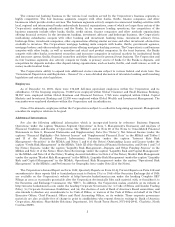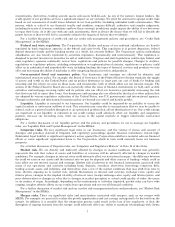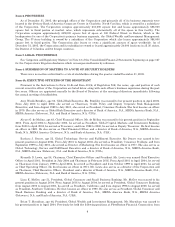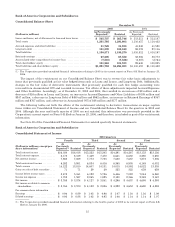Bank of America 2005 Annual Report Download - page 43
Download and view the complete annual report
Please find page 43 of the 2005 Bank of America annual report below. You can navigate through the pages in the report by either clicking on the pages listed below, or by using the keyword search tool below to find specific information within the annual report.commitments, derivatives, trading account assets and assets held-for-sale. As one of the nation’s largest lenders, the
credit quality of our portfolio can have a significant impact on our earnings. We allow for and reserve against credit risks
based on our assessment of credit losses inherent in our loan portfolio (including unfunded credit commitments). This
process, which is critical to our financial results and condition, requires difficult, subjective and complex judgments,
including forecasts of economic conditions and how these economic predictions might impair the ability of our borrowers
to repay their loans. As is the case with any such assessments, there is always the chance that we will fail to identify the
proper factors or that we will fail to accurately estimate the impacts of factors that we identify.
For a further discussion of credit risk and our credit risk management policies and procedures, see “Credit Risk
Management” in the MD&A.
Federal and state regulation. The Corporation, the Banks and many of our nonbank subsidiaries are heavily
regulated by bank regulatory agencies at the federal and state levels. This regulation is to protect depositors, federal
deposit insurance funds and the banking system as a whole, not security holders. The Corporation and its nonbanking
subsidiaries are also heavily regulated by securities regulators, domestically and internationally. This regulation is
designed to protect investors in securities we sell or underwrite. Congress and state legislatures and foreign, federal and
state regulatory agencies continually review laws, regulations and policies for possible changes. Changes to statutes,
regulations or regulatory policies, including interpretation or implementation of statutes, regulations or policies, could
affect us in substantial and unpredictable ways including limiting the types of financial services and products we may
offer and increasing the ability of nonbanks to offer competing financial services and products.
Governmental fiscal and monetary policy. Our businesses and earnings are affected by domestic and
international monetary policy. For example, the Board of Governors of the Federal Reserve System regulates the supply
of money and credit in the United States and its policies determine in large part our cost of funds for lending and
investing and the return we earn on those loans and investments, both of which affect our net interest margin. The
actions of the Federal Reserve Board also can materially affect the value of financial instruments we hold, such as debt
securities and mortgage servicing rights and its policies also can affect our borrowers, potentially increasing the risk
that they may fail to repay their loans. Our businesses and earnings also are affected by the fiscal or other policies that
are adopted by various regulatory authorities of the United States, non-U.S. governments and international agencies.
Changes in domestic and international monetary policy are beyond our control and hard to predict.
Liquidity. Liquidity is essential to our businesses. Our liquidity could be impaired by an inability to access the
capital markets or unforeseen outflows of cash. This situation may arise due to circumstances that we may be unable to
control, such as a general market disruption or an operational problem that affects third parties or us. Our credit ratings
are important to our liquidity. A reduction in our credit ratings could adversely affect our liquidity and competitive
position, increase our borrowing costs, limit our access to the capital markets or trigger unfavorable contractual
obligations.
For a further discussion of our liquidity picture and the policies and procedures we use to manage our liquidity
risks, see “Liquidity Risk and Capital Management” in the MD&A.
Litigation risks. We face significant legal risks in our businesses, and the volume of claims and amount of
damages and penalties claimed in litigation and regulatory proceedings against financial institutions remain high.
Substantial legal liability or significant regulatory action against the Corporation could have material adverse financial
effects or cause significant reputational harm to the Corporation, which in turn could seriously harm our business
prospects.
For a further discussion of litigation risks, see “Litigation and Regulatory Matters” in Note 13 of the Notes.
Market risk. We are directly and indirectly affected by changes in market conditions. Market risk generally
represents the risk that values of assets and liabilities or revenues will be adversely affected by changes in market
conditions. For example, changes in interest rates could adversely affect our net interest margin—the difference between
the yield we earn on our assets and the interest rate we pay for deposits and other sources of funding—which could in
turn affect our net interest income and earnings. Market risk is inherent in the financial instruments associated with
many of our operations and activities including loans, deposits, securities, short-term borrowings, long-term debt,
trading account assets and liabilities, and derivatives. Just a few of the market conditions that may shift from time to
time, thereby exposing us to market risk, include fluctuations in interest and currency exchange rates, equity and
futures prices, changes in the implied volatility of interest rates, foreign exchange rates, equity and futures prices, and
price deterioration or changes in value due to changes in market perception or actual credit quality of either the issuer
or its country of origin. Accordingly, depending on the instruments or activities impacted, market risks can have wide
ranging, complex adverse affects on our results from operations and our overall financial condition.
For a further discussion of market risk and our market risk management policies and procedures, see “Market Risk
Management” in the MD&A.
Merger risks. There are significant risks and uncertainties associated with mergers, such as our merger with
MBNA. For example, we may fail to realize the growth opportunities and cost savings anticipated to be derived from the
merger. In addition, it is possible that the integration process could result in the loss of key employees, or that the
disruption of ongoing business from the merger could adversely affect our ability to maintain relationships with clients
7
























